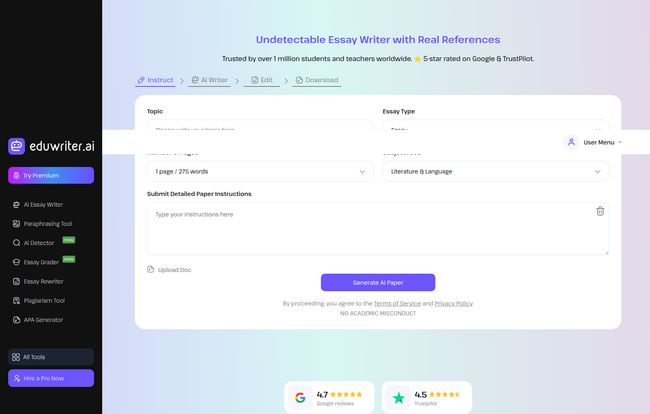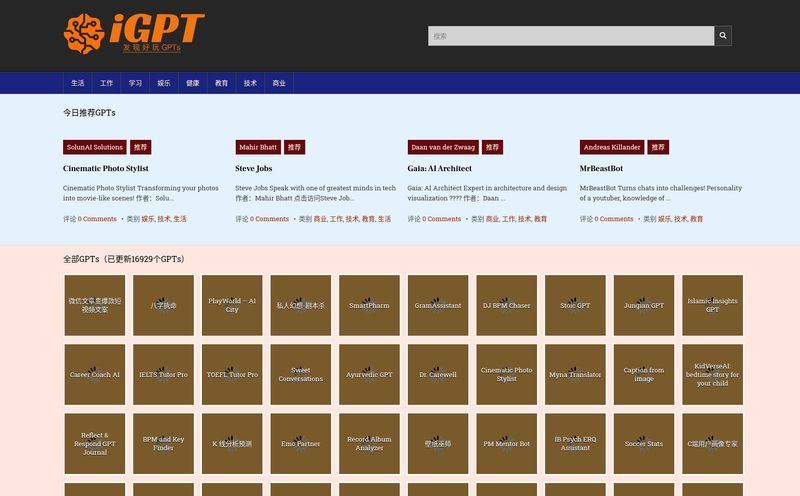It’s 1 AM. The cursor on your screen blinks, mocking you. That ten-page paper on the socioeconomic impact of Mesopotamian pottery isn’t just going to write itself, and the caffeine is starting to make you see sounds. We’ve all been there. That special kind of panic that only a looming deadline can produce. It’s a rite of passage, I guess. But what if it didn't have to be?
Lately, the SEO and content world has been absolutely buzzing with AI tools. They’re everywhere. And now, they’ve firmly planted their flag in the academic world. I’ve been keeping a close eye on this space, and one name that keeps popping up is EduWriter.ai. It makes some pretty bold claims about being an undetectable AI essay writer with real references. So, naturally, my professional curiosity (and the memory of my own all-night paper-writing sessions) got the better of me. I decided to take a look.

Visit EduWriter AI
So, What Exactly Is EduWriter? (And Why Should You Care?)
At its core, EduWriter presents itself as an AI-powered assistant designed specifically for students drowning in academic writing tasks. But calling it just an “essay writer” feels like a bit of an understatement. Based on my poking around, it’s more of an academic Swiss Army knife. The platform is built around a central AI that’s been trained on, and I quote, “5 Million of Human-Written Essays.” That’s... a lot of essays. The goal isn’t just to spit out text, but to generate customized, coherent, and—most importantly for students—plagiarism-free content.
This isn't just about getting a paper done. It's about having a suite of tools that can help with the entire writing process, from brainstorming and outlining to polishing and citing. For any student who has ever felt stuck, that’s a pretty compelling proposition.
A Look Under the Hood at EduWriter’s Core Features
Okay, let's get into the nitty-gritty. A tool is only as good as what it can actually do. EduWriter isn't a one-trick pony; it comes loaded with a bunch of different functions.
The AI Essay Writer Itself
This is the main event. You give it a topic, specify the length (in pages), and provide any other detailed instructions. From there, the AI gets to work. The two biggest claims here are that the output is undetectable by AI detectors and that it includes real references. The first point is a massive deal in the ongoing cat-and-mouse game between AI writing and plagiarism checkers like Turnitin. The second is equally important; nothing screams “I didn't write this” louder than fake or nonsensical citations. The promise of instant APA formatting is also a huge time-saver. Anyone who’s manually formatted a bibliography knows the pain.
More Than Just Writing: The Support Suite
This is where EduWriter starts to feel like a complete toolkit. It includes a Paraphrasing Tool and an Essay Rewriter. At first glance, they might seem similar, but in practice, they serve different purposes. The paraphraser is great for when you have a source you want to use but need to express it in your own words to avoid plagiarism. The rewriter, on the other hand, can take your own clunky draft and help you rephrase sentences for better flow and clarity. It's like having a friendly editor on call. There's also a Text Summarizer, which is fantastic for quickly getting the main points from a long article or research paper you don’t have time to read in full.
The Essential Integrity Checkers
Let's be real, the biggest fear for any student using a tool like this is getting flagged for academic dishonesty. EduWriter seems to understand this and has built-in safety nets. It includes its own AI Detector to check if the text sounds too robotic, and a Plagiarism Checker to ensure the content is original. I think this is a smart move. It gives users a way to double-check the work before they even think about submitting it, which adds a much-needed layer of confidence.
My Honest Take: The Good, The Bad, and The Realistic
After playing around with EduWriter, I've got some thoughts. No tool is perfect, and it’s all about knowing what you’re getting into.
On the plus side, it’s fast. It can generate a first draft in moments, which is a lifesaver for beating writer's block. The variety of tools is a genuine advantage, and the focus on academic specifics like APA formatting and real references is a clear differentiator from more generic AI writers like ChatGPT. The free version is also a great way to test the waters without commitment.
However, let's manage expectations. The free version is quite limited—one page per day isn't going to cut it for a major assignment. And like any AI, the quality of the output is directly proportional to the quality of the input. If you give it a vague, one-word prompt, you’re going to get a vague, generic essay. You need to provide detailed instructions to get the best results. I also suspect that for truly long-form, deeply nuanced papers like a thesis or dissertation, this tool is best used for outlines and drafts, not the final product. A human touch is still irreplaceable for that level of work.
Let's Talk Money: EduWriter's Pricing Breakdown
So, what's this going to cost you? EduWriter has a pretty straightforward pricing structure that caters to different needs and budgets. It's not one of those platforms with a dozen confusing tiers, which I appreciate.
Here’s how it breaks down:
- Free Plan ($0/month): This is your entry point. You get 1 page from the AI writer per day, 1 page of paraphrasing, and access to the APA format generator. It’s limited, but its perfect for getting a feel for the tool.
- Premium Monthly ($19/month): This unlocks the whole platform. Unlimited AI writer, unlimited paraphrasing, 3 plagiarism reports per month, and access to all the other tools like the summarizer, text generator, and AI detector.
- Premium Quarterly ($14/month): Same as the monthly plan, but you save a few bucks by paying for three months upfront.
- Premium Yearly ($11/month): This is the best bang for your buck, by far. If you know you'll be writing papers all year, this plan offers the most significant savings.
In my opinion, if you’re a serious student who foresees a semester packed with essays, the yearly plan is a no-brainer. The cost per month is less than a few fancy coffees and the utility you get is substantial. For a one-off project, the monthly plan is probably sufficient.
Who is EduWriter Really For?
This is the million-dollar question. I don’t see this as a tool for someone looking to cheat the system. The built-in checkers and the need for detailed prompts suggest it’s designed for a more collaborative process. I think EduWriter is ideal for a few types of people:
- The Student with Writer's Block: Someone who is staring at a blank page and just needs a starting point, an outline, or a few well-phrased paragraphs to get the ball rolling.
- The ESL Student: For non-native English speakers, it can be an incredible aid for improving sentence structure, grammar, and vocabulary, helping them express their own ideas more fluently.
- The Time-Crunched Student: Let's face it, sometimes life gets in the way. This tool can help generate a solid first draft that you can then edit, fact-check, and personalize, saving you precious hours.
It’s a co-pilot, not an autopilot. The best way to use it is as a thinking partner—a way to brainstorm, structure, and refine your own work, not to replace it entirely.
Frequently Asked Questions about EduWriter
Can I really use EduWriter for free?
Yes, absolutely. EduWriter offers a free plan that gives you daily limited access to the AI writer and paraphrasing tool. It's a great way to try it out, but for unlimited access and all the premium features, you'll need a paid subscription.
Is the content from EduWriter plagiarism-free?
The platform is designed to produce original content and even includes a built-in plagiarism checker. However, as a best practice, I'd always recommend running the final text through your school's preferred checker (like Turnitin) just to be 100% sure. Think of it as a final proofread.
Does it actually provide real, usable references?
This is one of its major selling points. Unlike some early AI models that would invent sources (a phenomenon known as 'hallucination'), EduWriter claims to pull from real academic sources and format them correctly in APA style. You should still double-check them, of course, but it’s a massive step up.
Will my professor know I used an AI writer?
EduWriter claims its output is 'undetectable.' While their model is likely trained to sound more human than generic AIs, there's no foolproof guarantee in the rapidly evolving world of AI detection. The best way to use the tool is to heavily edit the output, add your own insights, and infuse it with your unique voice. Use it as a base, not the final word.
Can I write different types of essays?
Yes. By providing clear and detailed instructions in the prompt, you can guide the AI to generate different types of essays, whether it's argumentative, persuasive, narrative, or expository. The more specific you are with your request, the better the result will be.
Final Thoughts on EduWriter.ai
So, is EduWriter.ai the magic wand that will solve all your academic writing woes? No, because such a thing doesn't exist. But is it a powerful, well-designed tool that can act as an incredibly useful co-pilot? Absolutely.
I went in skeptical, as I do with most AI tools making big promises. But I came away impressed with its focus on the actual needs of a student: originality, proper citations, and ease of use. It's not about replacing critical thought; it's about augmenting it. It helps you get past the grunt work of formatting and the terror of the blank page, so you can focus on what really matters—your ideas. If you use it wisely, as an assistant rather than a replacement, EduWriter could genuinely change the way you approach your next big paper.
References and Sources
- EduWriter Homepage: https://eduwriter.ai/
- EduWriter Pricing Information: https://eduwriter.ai/pricing



